Frozen Delights
How to Draw Ice Cream: Easy Steps for Sweet Illustrations!
Melt hearts with simple steps to create charming ice cream illustrations, perfect for adding sweetness to your art!

Create adorable ice cream illustrations easily! Start with a curved dome shape for the ice cream and add a stick for a popsicle look. Keep the stick centered and add a sweet smile for personality. Play with eye details for expressions. Try heart shapes for love vibes. Add drizzles with curved lines for depth. Finally, sprinkle decorations elevate your artwork. Happy drawing these sweet treats!
Key Takeaways
- Start with a dome shape sketch for the ice cream.
- Add a stick for popsicle formation.
- Draw realistic eyes and a sweet smile for character.
- Incorporate heart shapes for whimsical design.
- Use drizzling and sprinkle techniques for decoration.
Dome Shape Sketch

To start drawing ice cream, sketch a large curved form at the top to outline the dome of the ice cream. This dome shape is essential as it establishes the base for your sweet illustration. Make sure the curve is smooth and rounded to capture the authentic look of ice cream.
Using gentle pencil strokes, carefully outline the dome shape, ensuring it's slightly flattened at the top to imitate the classic scoop appearance. By concentrating on getting this dome shape just right, you set the foundation for the remainder of your ice cream drawing.
Pay attention to the intricacies and proportions as you work on this initial sketch, as they'll significantly impact the overall appearance of your ice cream illustration. Remember, practice makes perfect, so don't hesitate to adjust and refine your dome shape until you're content with it.
Popsicle Formation

To form a popsicle, start by drawing a large curve for the shape and then bring it down smoothly.
Next, add a stick with two straight lines connected at the bottom.
These simple steps will help you create the basic popsicle structure before adding more detailed features.
Shape of Popsicle
Start by sketching a large curve at the top to establish the dome shape of the popsicle. Next, bring the curve down smoothly and symmetrically to create the basic popsicle shape. It's vital to make sure that the sides are even and well-balanced to maintain a pleasing appearance.
Adding a stick is essential; draw two straight lines connected with a curve at the bottom of the popsicle to complete its look.
The shape of the popsicle sets the foundation for the rest of your illustration. Make sure the curves are gentle and the lines are clean, giving your popsicle a realistic and appealing appearance. A well-formed popsicle will serve as the focal point of your drawing, capturing the essence of this delightful treat.
Adding Stick Detail
Consider improving the authenticity of your popsicle illustration by carefully incorporating the stick detail, made up of two straight lines connected by a curved line at the base. When adding the stick to your popsicle drawing, make certain to keep the lines straight and the curve smooth for a polished look. Here's a simple guide to help you with this step:
| Step | Instructions | Example |
|---|---|---|
| 1 | Draw two vertical straight lines. |  |
| 2 | Connect the bottom of the lines with a curved line. |  |
| 3 | Verify the stick is centered and proportionate. |  |
| 4 | Finalize by adding any additional details. |  |
Now that you have the stick detail in place, go ahead and complete your popsicle illustration with confidence. Adding this small element will make a significant difference in the overall appearance of your drawing.
Stick Addition

When adding a stick to your ice cream drawing, remember to keep it centered and proportional for a realistic touch.
Connect two straight lines with a curved base to form the stick.
This step completes the traditional look of a classic popsicle treat.
Stick Structure
Add the stick to your ice cream drawing by creating two straight lines connected with a curve at the base. Confirm that the stick is centered under the ice cream cone to maintain balance and proportion.
Here are some tips to help you perfect the stick structure:
- Proportion Matters: Make certain the stick is the appropriate size in relation to the ice cream cone; too big or too small can throw off the illustration.
- Secure Attachment: Draw the stick firmly attached to the base of the ice cream cone for stability and realism.
- Complementary Design: The stick should flow naturally with the overall shape and design of the ice cream, enhancing the visual appeal of your drawing.
Attaching Stick
To attach the rod to your ice cream drawing, draw two straight lines extending from the base of the popsicle and connect them with a curved line to form the rod. Make sure the rod is centered and proportionate to the popsicle for a balanced look. Adding texture like wood grain or a glossy finish can enhance realism. Adjust the rod's length and thickness to match the popsicle's size and shape for a cohesive appearance.
| Rod Attachment Tips |
|---|
| Draw two straight lines from the popsicle's base. |
| Connect lines with a curved line to create the rod. |
| Keep rod centered and proportional for balance. |
| Add texture or details like wood grain for realism. |
| Adjust rod length and thickness based on popsicle size. |
Eye Drawing Technique

For creating realistic and expressive eyes in your ice cream drawings, start by using two circles of different sizes to form the basic structure. This technique will give your ice cream character a cute and lively appearance.
To further enhance the eyes, consider the following tips:
- Add highlights inside the eyes: Incorporate smaller circles or ovals to make the eyes look shiny and full of life.
- Experiment with pupil sizes and positions: Different sizes and placements of pupils can convey various emotions or expressions in your drawing.
- Include eyelashes or eyelids: Adding these details can give your ice cream character unique features and personality.
Sweet Smile Detailing

Enhancing your ice cream drawing with a sweet smile detailing can infuse personality and warmth into the character, elevating its charm and appeal. A simple curved line placed strategically under the eyes of your ice cream illustration can create an adorable smile, making the popsicle look friendly and inviting. By incorporating a sweet smile, you can enhance the emotional appeal of your ice cream drawing, making it more relatable and endearing to your audience.
The addition of a smile can complement the overall cuteness of the popsicle design, adding a touch of playfulness to the character. This sweet detailing not only brings character to your illustration but also helps to establish a connection with the viewer through its friendly and approachable demeanor.
Experiment with different smile variations to find the perfect expression that suits your ice cream drawing's personality and style.
Blush Application

Adding blush to the cheeks of your ice cream character brings a touch of color and liveliness to the illustration. It's a simple yet effective way to enhance the cuteness and charm of your drawing.
Here's how you can make your ice cream character blush come to life:
- Choose the Right Tone: Opt for pink or peach blush tones to complement the sweetness of your ice cream character. These colors will help create a warm and inviting look.
- Adjust Intensity: Depending on the desired effect, you can apply the blush lightly for a subtle hint of color or more heavily for a rosy-cheeked appearance. Experiment with different intensities to find the perfect balance.
- Placement Matters: The placement of the blush on the cheeks can convey different emotions. For a softer look, apply the blush higher on the cheeks. If you want a more pronounced blush, focus the color on the apples of the cheeks.
Heart Shape Inclusion

To add an extra dose of cuteness and charm to your ice cream illustration, consider incorporating a heart shape into the design near the top of the popsicle. This simple addition can elevate the visual appeal of your drawing and make it more engaging.
By adding a heart shape, you can personalize the illustration and create a sweet touch that resonates with viewers.
When drawing the heart shape, you can choose to color it in a contrasting hue to make it stand out and add charm to the overall design. The heart shape near the top of the popsicle can evoke feelings of love and happiness, making your artwork more endearing and appealing to the eye.
This uncomplicated addition can make a significant difference in the overall look and feel of your ice cream illustration, adding a touch of whimsy and sweetness.
Drizzling Technique

Try incorporating the drizzling technique in your ice cream drawing to bring a realistic touch of liquid or sauce flowing over the popsicle. Drizzling adds depth and movement to your illustration, making it more appealing to the eye.
Here are some tips to master the art of drizzling on your ice cream popsicle:
- Random Curved Lines: Create a natural look by drawing curved lines in a random pattern to simulate the flow of melted ice cream or syrup on the popsicle.
- Vary Length and Thickness: Experiment with different lengths and thickness of the drizzles to give your drawing a dynamic and realistic appearance.
- Unique Styles and Patterns: Explore various drizzling styles and patterns to add a creative twist to your ice cream illustration. You can try zig-zag lines, loops, or even swirls to make your popsicle stand out.
Sprinkle Decoration

Incorporate a delightful touch to your ice cream illustration by adorning it with vibrant and varied sprinkles.
Sprinkles, those small decorative confectionery pieces, come in a plethora of shapes, colors, and sizes, ranging from round to long and from rainbow to chocolate.
Typically made of sugar, corn syrup, vegetable oil, natural and artificial flavors, and food coloring, sprinkles serve as the perfect embellishment for ice cream, enhancing both its visual appeal and taste.
By drizzling or scattering sprinkles in creative patterns, you can craft unique and eye-catching designs on your illustrated ice cream.
Whether you opt for a classic sprinkle blend or experiment with different combinations, sprinkles offer a fun and customizable way to elevate your dessert drawing.
Frequently Asked Questions
How to Make a Drawing of Ice Cream?
To draw ice cream, start with a curved dome shape for the scoop. Add a stick using two lines connected by a curve. Create eyes with circles and highlights. Drizzle with curves and sprinkle in different directions for fun.
How Do You Draw a Cute Popsicle Easy?
Creating a cute popsicle is a breeze! Start with a gentle curve for the dome, draw the stick, add adorable eyes and a sweet smile. Finish with drizzles and sprinkles for a fun touch. You'll nail it!
How to Draw a Scoop of Ice Cream?
To draw a scoop of ice cream, start with a rounded shape. Add texture with curved lines or swirls. Include a cone or cup below. Shade for a 3D look. Finish with sprinkles, a cherry, or syrup.
How to Draw Simple Drawings?
To draw simple drawings, start with basic shapes and lines. Focus on the overall composition and use minimal details. Outline lightly in pencil before adding final touches. Practice regularly to improve and create more intricate designs.
Can I Use My Drawing of Ice Cream to Decorate My Homemade Ice Cream in a Bag?
Absolutely! Using your drawing of ice cream to decorate your homemade ice cream in a bag is a fun and creative way to personalize your treat. It adds a special touch to your homemade ice cream recipe in bag and makes the experience even more enjoyable.
Can I Use the Same Steps to Draw Ice Cream for My Dog’s Treats?
Yes, you can use the same steps to draw ice cream for your dog’s treats in the UK. Just be sure to use ingredients that are safe for dogs, such as yogurt, banana, and peanut butter, and avoid any harmful additives. Your dog will love the homemade dog ice cream treats UK!
Conclusion
Now that you've mastered the art of drawing ice cream, let your creativity flow like sprinkles on a sundae. Remember, every stroke and detail adds sweetness to your illustration.
So grab your pencil, add some heart-shaped toppings, and let your ice cream creation shine like a summer day.
Keep practicing and soon you'll be scooping up masterpieces with ease!
As the Editor-in-Chief, Sara ensures that every piece of content published on the website is informative, engaging, and easy to follow. She believes in empowering readers to explore their creativity and experiment with various flavors and toppings. Sara’s step-by-step guides and clear instructions enable ice cream enthusiasts to create their own customized masterpieces that will impress friends and family.
With a wealth of experience in the culinary world, Sara brings a creative touch to Dri Dri Gelato’s content. She understands that ice cream is more than just a dessert—it’s a delightful experience that can bring joy and excitement to any occasion. Sara’s expertise lies in not only creating delicious ice cream recipes but also in teaching others the art of making ice cream at home, from the basics to the more advanced techniques.
Frozen Delights
Pomegranate Spritz
Glimmering with pomegranate juice and sparkling wine, the Pomegranate Spritz is a refreshingly sophisticated cocktail that invites you to indulge in its vibrant flavors.

The Pomegranate Spritz is a refreshing Italian-inspired cocktail that combines tart pomegranate juice, effervescent sparkling wine, and a touch of citrusy lemon. Popularized in the 2000s, this sophisticated drink has become a beloved summertime favorite across Europe and the U.S. To make, you'll muddle pomegranate seeds, add the sparkling wine and lemon juice, then strain into a chilled coupe glass. Top it off with a garnish of pomegranate arils for a vibrant, visually stunning presentation. This easy-to-prepare cocktail encourages creativity and can be adjusted to suit your taste preferences – perfect for both intimate gatherings and larger celebrations.
Key Takeaways
- The Pomegranate Spritz is a refreshing cocktail originating in Italy, combining pomegranate juice, sparkling wine, and soda water for a sophisticated flavor profile.
- The cocktail features a balance of tart and sweet notes, making it a popular summertime favorite enjoyed in various settings.
- The recipe requires minimal ingredients, including pomegranate juice, sparkling wine, lemon juice, and honey, allowing for quick preparation.
- Garnishing the Pomegranate Spritz with pomegranate arils adds color, crunch, and extra flavor, enhancing the overall visual appeal and taste experience.
- The Pomegranate Spritz represents a blend of tradition and innovation, encouraging creativity in mixology and cocktail crafting.
History
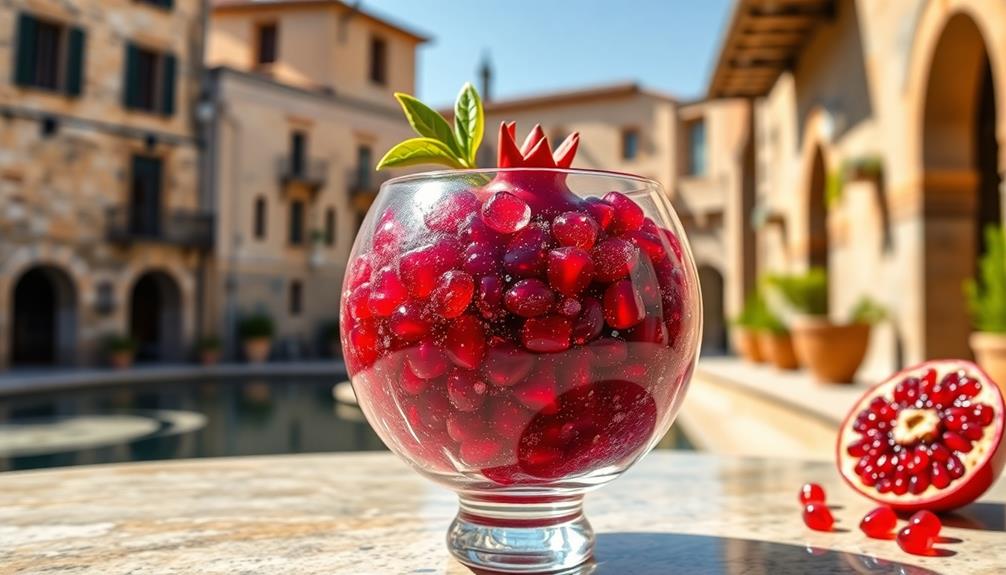
Though the pomegranate has been cultivated for centuries, the pomegranate spritz is a relatively modern cocktail. The origins of this refreshing beverage can be traced back to Italy, where mixologists began experimenting with the tart, sweet flavor of pomegranate juice in the early 2000s.
Traditionally, the pomegranate spritz is made by combining pomegranate juice, sparkling wine, and a touch of soda water. This combination creates a vibrant, effervescent drink that perfectly balances the pomegranate's natural acidity with the lightness of the sparkling wine.
As the pomegranate spritz gained popularity in Italy, it soon began to spread across Europe and eventually made its way to the United States.
Today, this cocktail has become a beloved summertime favorite, offering a unique and sophisticated twist on the classic spritz formula. Whether enjoyed on a sunny patio or as a refreshing aperitif, the pomegranate spritz has cemented its place as a modern classic.
Recipe

Pomegranate Spritz is a refreshing and vibrant cocktail that captures the essence of the pomegranate fruit. This fizzy beverage combines the tart and sweet flavors of pomegranate juice with the effervescence of sparkling wine, creating a delightful balance that's perfect for any occasion.
Whether you're hosting a sophisticated dinner party or simply seeking a refreshing sip on a warm day, the Pomegranate Spritz is sure to impress. Its vibrant hue and elegant presentation make it a visually stunning addition to any gathering.
Ingredients:
- 4 oz pomegranate juice
- 2 oz dry sparkling wine
- 1 oz freshly squeezed lemon juice
- 1 tbsp honey (or to taste)
- Ice cubes
- Pomegranate arils for garnish (optional)
To prepare the Pomegranate Spritz, start by adding the pomegranate juice, lemon juice, and honey to a cocktail shaker filled with ice. Shake vigorously until well-chilled. Strain the mixture into a champagne flute or wine glass.
Top with the sparkling wine and stir gently to combine. Finally, garnish with a few pomegranate arils, if desired.
When making the Pomegranate Spritz, be sure to use a high-quality pomegranate juice and a dry, crisp sparkling wine to achieve the perfect balance of flavors.
Adjust the honey to your desired sweetness level. The garnish of pomegranate arils not only adds a beautiful touch but also provides a burst of fresh pomegranate flavor in every sip.
Cooking Steps

First, you'll want to muddle the pomegranate seeds in a cocktail shaker to release their juices.
Then, add the sparkling wine and a splash of lemon juice.
Step 1. Muddle Pomegranate Seeds in Cocktail Shaker
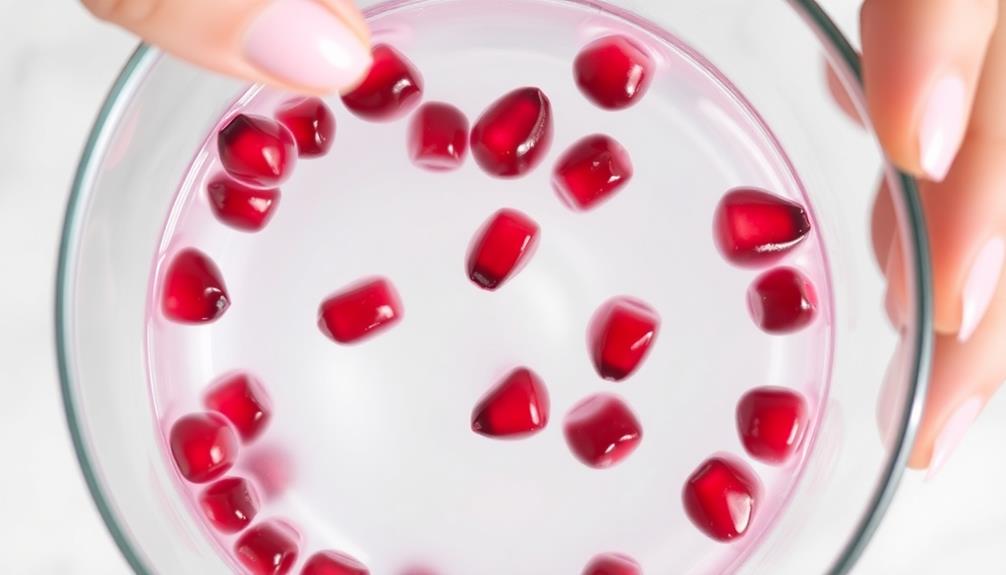
In your cocktail shaker, gently muddle the pomegranate seeds. Use the back of a spoon or a muddler to crush the seeds, releasing their vibrant juice and tangy aroma.
This action will create a luscious, ruby-red base for your Pomegranate Spritz. The invigorating scent of pomegranate can also uplift your mood, similar to how aromatherapy can stimulate the limbic system, enhancing your overall experience.
Next, add the vodka and freshly squeezed lemon juice. The acidity from the lemon will help balance the sweetness of the pomegranate.
Secure the lid and shake vigorously for about 10 seconds to thoroughly combine the ingredients.
Now, fill a highball glass with ice cubes. Strain the shaker contents over the ice, then top with chilled soda water.
The sparkling water will add a refreshing, effervescent touch to the cocktail.
Step 2. Add Sparkling Wine
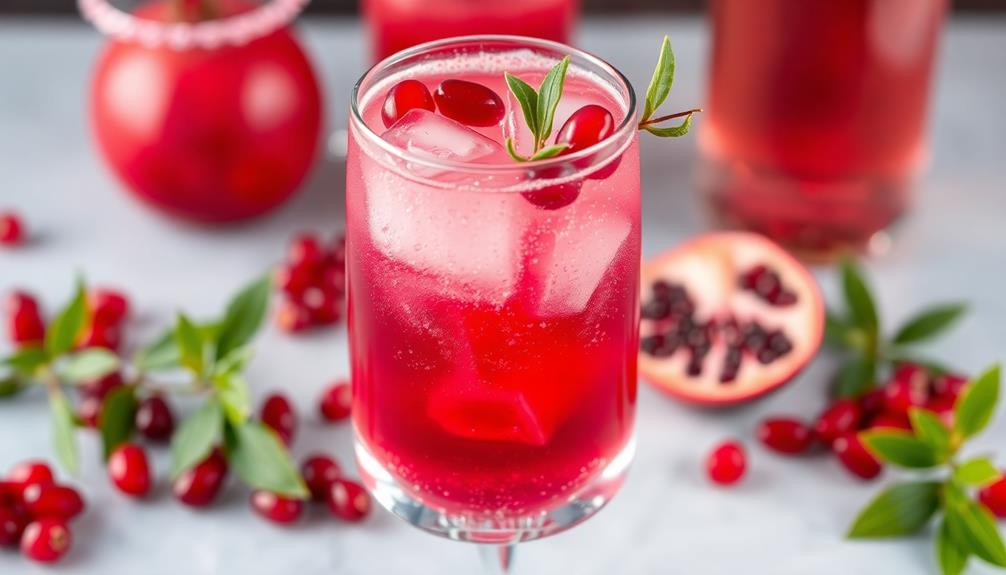
Why not add a splash of sparkling wine to your Pomegranate Spritz? Doing so will elevate the drink, adding a touch of effervescence and a hint of dryness to balance out the sweetness of the pomegranate.
Simply pour 2-3 ounces of your favorite dry sparkling wine into the cocktail shaker, being careful not to overfill it.
Once the sparkling wine is added, give the mixture a gentle stir to incorporate all the ingredients. This will help create a harmonious blend of flavors.
Strain the Pomegranate Spritz into a chilled glass, ensuring the fizz is preserved. You can garnish the drink with a few fresh pomegranate seeds or a lemon twist for a vibrant finishing touch.
The sparkling wine adds a festive touch to the Pomegranate Spritz, making it the perfect cocktail for celebrating special occasions or enjoying a relaxing evening.
The combination of the sweet pomegranate and the dry, bubbly wine creates a refreshing and sophisticated sip.
Step 3. Add Lemon Juice

To add a fresh, citrusy note to your Pomegranate Spritz, squeeze a generous amount of lemon juice into the cocktail shaker. This bright, acidic element will help balance the sweetness of the pomegranate and create a more dynamic, refreshing flavor profile.
When selecting your lemon, opt for a juicy, ripe variety that's heavy for its size. Roll it firmly on the counter before cutting to help release more of the aromatic oils.
Slice the lemon in half and, using a citrus reamer or the tines of a fork, extract as much juice as possible, being careful to avoid any seeds.
Add the lemon juice to the shaker, along with the pomegranate juice and simple syrup. Secure the lid and shake vigorously for 10-15 seconds to fully incorporate the ingredients.
Strain the mixture into your serving glass and top with chilled sparkling wine. Garnish with a lemon twist for an extra pop of citrus.
Step 4. Strain Into Chilled Coupe Glass
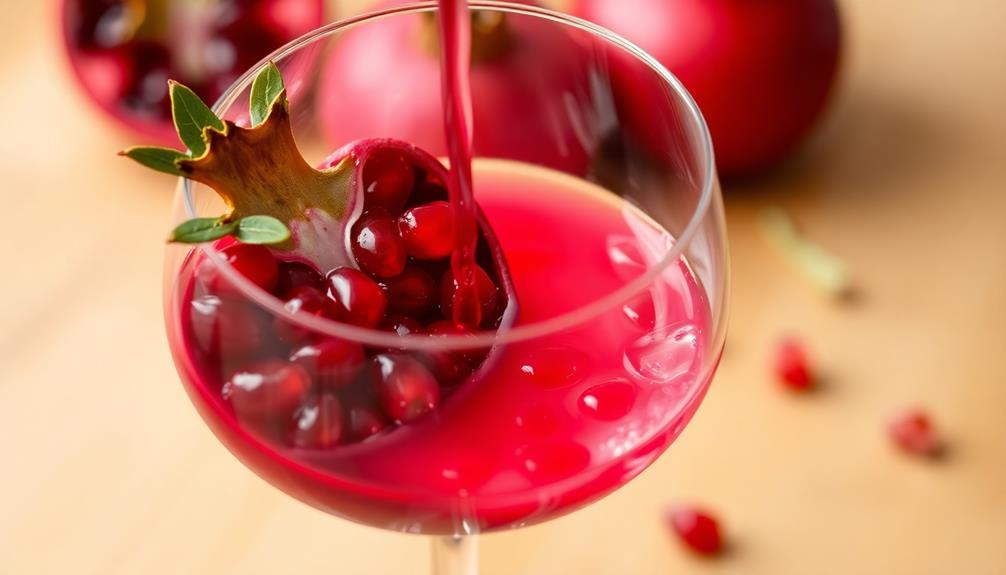
After vigorously shaking the ingredients, it's time to strain the cocktail into a chilled coupe glass. This step is crucial for achieving the desired texture and appearance of the Pomegranate Spritz.
Using a fine-mesh strainer, carefully pour the mixture through, ensuring to catch any pulp or ice chips. The strainer will help create a smooth, well-integrated drink, free from any unwanted solids.
Once strained, the vibrant, ruby-red liquid should be poured directly into the chilled coupe glass. This style of glass, with its wide, shallow bowl, is perfect for showcasing the Pomegranate Spritz's beautiful color and aroma.
The chilled glass will also help maintain the cocktail's refreshing temperature, allowing you to fully enjoy its balanced flavors.
With the cocktail now strained and in its serving vessel, you're ready to garnish and serve this refreshing Pomegranate Spritz. The final touch will elevate the drink's presentation and amplify its aromatic qualities.
Step 5. Garnish With Pomegranate Arils
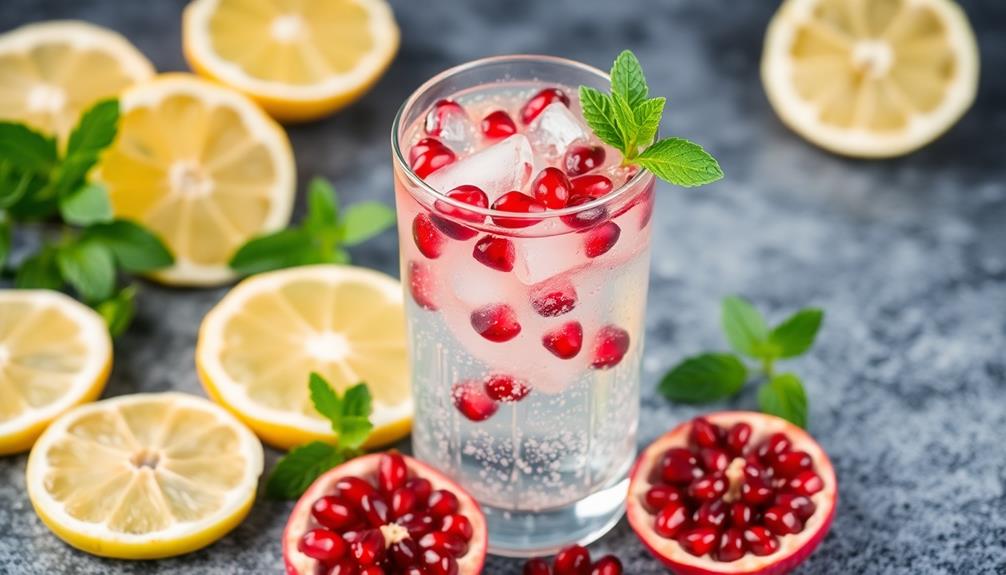
For the final touch, garnish the Pomegranate Spritz with a few pomegranate arils. These ruby-red jewels not only add a burst of color, but they also provide a delightful crunch and a sweet-tart flavor that complements the drink perfectly.
Additionally, pomegranate arils are rich in antioxidants, which may help support overall health and boost your immune system, making your drink not just delicious but also beneficial for you health benefits.
Pomegranate arils are the edible seeds found inside the pomegranate fruit. To extract them, simply cut the pomegranate in half, then use your fingers to gently pull the arils away from the bitter white pith.
Discard the pith, and you're left with a handful of beautiful, glistening arils. Carefully drop 3-5 pomegranate arils into the chilled Pomegranate Spritz, ensuring they float atop the vibrant pink liquid.
The arils will sink slightly, creating a visually striking effect as they dance and bob in the drink. Serve the Pomegranate Spritz immediately, allowing your guests to enjoy the interplay of flavors and textures with each sip and bite.
Final Thoughts

With a refreshing and light-hearted twist, the Pomegranate Spritz is a delightful cocktail that's sure to impress. The vibrant ruby-hued arils not only add a pop of color but also a burst of tart, sweet flavor that perfectly complements the effervescent bubbles.
Whether you're hosting a summer soiree or simply indulging in a relaxing evening at home, this versatile spritz is a crowd-pleasing choice. Its balance of flavors – from the tartness of the pomegranate to the subtle sweetness of the simple syrup – creates a truly unique and memorable sipping experience.
As you savor each refreshing sip, let the Pomegranate Spritz transport you to a world of refreshment and delight. With its easy-to-follow recipe and stunning presentation, this cocktail is sure to become a new favorite in your repertoire.
Raise a glass and toast to the perfect blend of tradition and innovation – the Pomegranate Spritz.
Frequently Asked Questions
Where Can I Purchase Pomegranate Juice Concentrate?
You can purchase pomegranate juice concentrate at your local grocery store, specialty food shop, or online retailers. Look for it near other fruit juices and concentrates. Many brands offer pomegranate concentrate for making juices, cocktails, and other recipes.
How Long Does the Pomegranate Spritz Stay Carbonated?
The carbonation in your drink will typically last for a few hours, though it may start to dissipate over time. To maintain the fizz, be sure to keep your spritz chilled and avoid letting it sit out at room temperature.
Can I Use a Different Type of Sparkling Wine?
You can absolutely use a different type of sparkling wine in your cocktail. Experiment with different styles, like Prosecco or Cava, to find the flavor profile that best suits your taste. Just be mindful of the carbonation level.
Is the Pomegranate Spritz Suitable for Vegetarians/Vegans?
Is the drink suitable for vegetarians and vegans? To determine this, you would need to check the ingredient list to ensure there are no animal-derived ingredients. As long as the ingredients are plant-based, the drink should be suitable for those following a vegetarian or vegan diet.
What Is the Ideal Glassware for Serving the Pomegranate Spritz?
For the best presentation, you'll want to serve the drink in a stemmed wine glass or a coupe glass. These elegant glassware options will showcase the vibrant color and bubbles of the cocktail.
Mario’s creativity shines through his ability to describe the sensory experience of enjoying ice cream. Whether he’s discussing the velvety texture, the explosion of flavors, or the delightful combinations of toppings and sauces, his words transport readers to a world of mouthwatering sensations. His descriptive language allows readers to imagine and savor the flavors even before taking the first bite.
Frozen Delights
Lemon Basil Spritz
Discover the refreshing and aromatic Lemon Basil Spritz, a Mediterranean-inspired cocktail that combines the zesty flavors of lemon and the fragrant aromas of fresh basil.
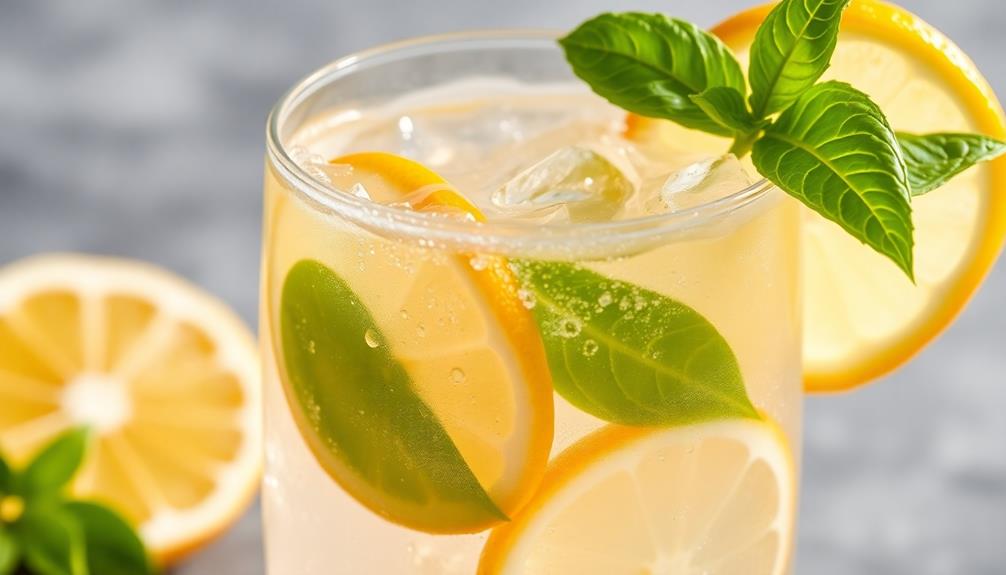
The Lemon Basil Spritz is a refreshing Mediterranean-inspired cocktail that combines the zesty flavors of lemon and the fragrant aromas of fresh basil. Originating in the Mediterranean region and influenced by Italian culinary traditions, this light and effervescent cocktail is perfect for summer gatherings, palate cleansers, or year-round enjoyment. You'll find it features a mix of vodka, fresh lemon juice, simple syrup, basil leaves, and sparkling water. To craft this cocktail, you'll muddle the ingredients, add the fizzy water and ice, then stir and garnish for a delightful tipple. Continue reading to discover more about the history and preparation of this versatile spritz.
Key Takeaways
- The Lemon Basil Spritz is a light, effervescent cocktail that originated in the Mediterranean region, combining zesty lemon and fragrant basil flavors.
- The cocktail is typically made with vodka, fresh lemon juice, simple syrup, basil leaves, and sparkling water, providing a refreshing and versatile drinking experience.
- Preparation involves muddling the lemon and basil, adding the other ingredients, and garnishing with a lemon slice and basil sprig for an optimal presentation.
- The Lemon Basil Spritz is well-suited for summer gatherings, as a palate cleanser, or year-round enjoyment, and can also be enjoyed as a non-alcoholic version.
- The cocktail contains natural, low-calorie ingredients, with potential health benefits from the antioxidants in basil and the vitamin C in lemon.
History

The origins of the lemon basil spritz can be traced back to the sun-soaked Mediterranean region, where the vibrant flavors of citrus and aromatic herbs have long captivated the palates of locals and travelers alike.
This refreshing cocktail likely emerged from the rich culinary traditions of Italy, where the combination of tart lemon, fragrant basil, and sparkling wine has been celebrated for generations.
Lemon and basil have been prized ingredients in Mediterranean cuisine for centuries, lending their distinct flavors to a vast array of dishes.
As the popularity of aperitif cocktails grew, inventive bartenders began experimenting with these beloved flavors, creating a harmonious balance between the herbal notes of basil and the bright, citrusy punch of lemon.
The result is the lemon basil spritz – a light, effervescent libation that perfectly captures the essence of the Mediterranean.
Recipe
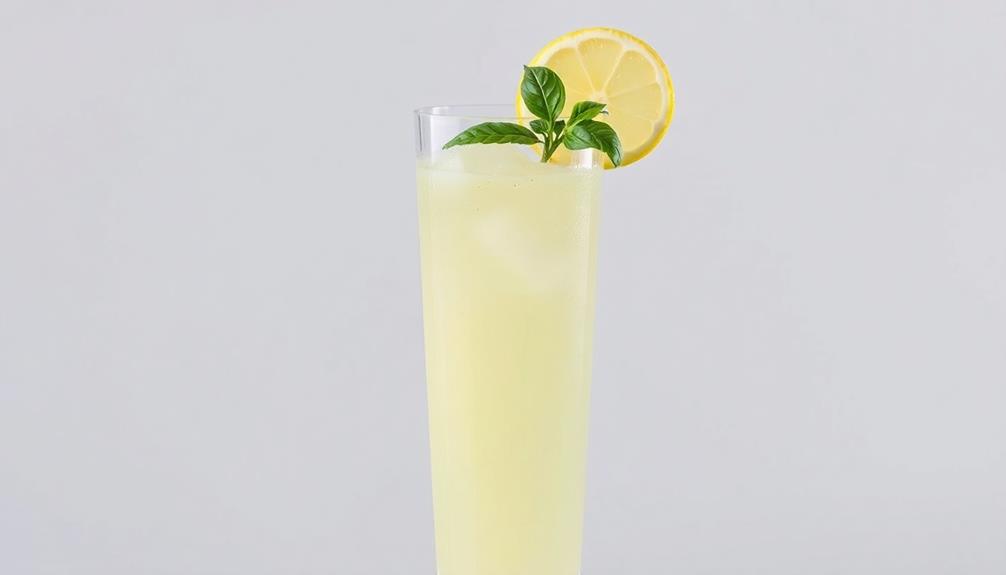
The Lemon Basil Spritz is a refreshing and vibrant cocktail that combines the zesty flavors of lemon and the fragrant notes of fresh basil.
This versatile drink can be enjoyed on its own or as a mixer, making it a perfect choice for summer gatherings or as a palate cleanser between courses.
The key to this cocktail's success lies in the careful balance of its ingredients and the use of fresh, high-quality components. By following this recipe, you'll be able to create a Lemon Basil Spritz that's sure to delight your taste buds.
Ingredients:
- 2 oz vodka
- 1 oz fresh lemon juice
- 1 oz simple syrup
- 8-10 fresh basil leaves
- Sparkling water
- Ice
Instructions:
In a cocktail shaker, muddle the basil leaves with the simple syrup.
Add the vodka and lemon juice, then fill the shaker with ice.
Shake vigorously for 10-15 seconds until well-chilled.
Strain the mixture into a highball or Collins glass filled with ice.
Top with sparkling water and stir gently to combine.
Serve the Lemon Basil Spritz immediately, garnished with a fresh basil leaf or a lemon twist.
For optimal freshness and flavor, use the freshest possible basil and lemon juice.
Additionally, consider adjusting the sweetness to your personal taste by adding more or less simple syrup as desired.
Cooking Steps
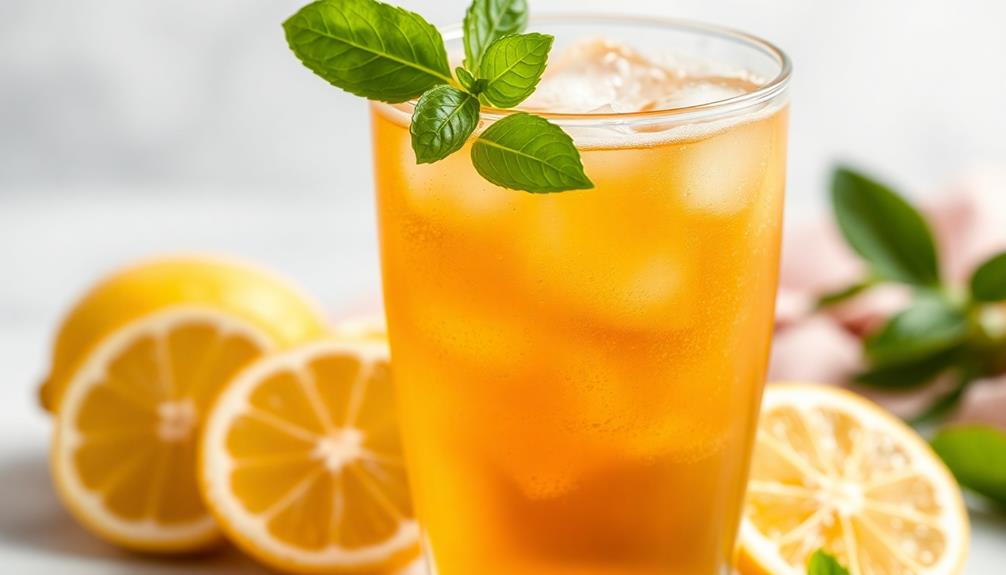
In a glass, gently muddle the fresh lemon slices, basil leaves, and a touch of sugar until the flavors meld.
Next, add the fizzy water and a handful of ice cubes.
Stir the mixture well, then garnish with a thin lemon slice before serving the chilled Lemon Basil Spritz immediately.
Step 1. Muddle Lemon, Basil, and Sugar
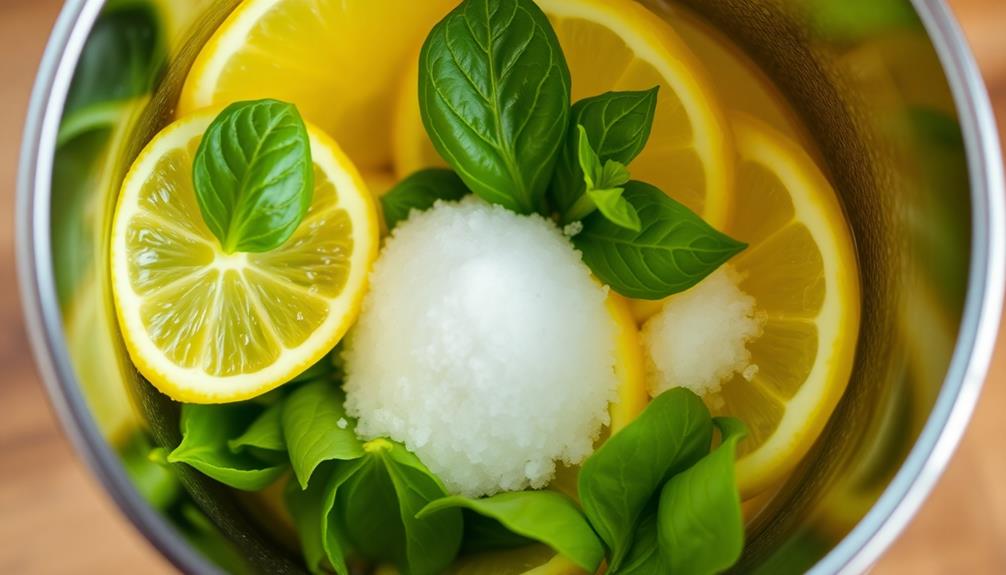
To begin the Muddle Lemon, Basil, and Sugar, start by grabbing a cocktail muddler or the back of a spoon.
In a sturdy glass or shaker, add the fresh lemon slices and lightly bruise them to release their aromatic oils.
Next, tear or chiffonade the basil leaves and add them to the glass.
Sprinkle in the granulated sugar, then use your muddler or spoon to gently press and twist the ingredients together.
This process, known as muddling, helps to extract the flavors from the lemon and basil, while dissolving the sugar.
Be careful not to over-muddle, as this can result in a bitter, herbaceous flavor.
Once the ingredients are well-combined, you're ready to move on to the next step in creating your refreshing Lemon Basil Spritz.
Step 2. Add Fizzy Water
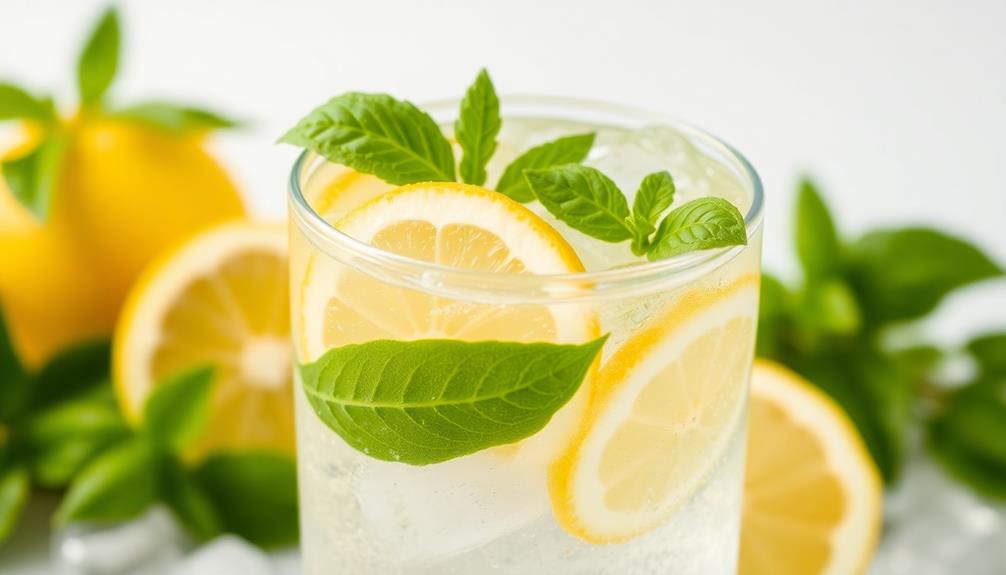
Next, add the fizzy water to your muddled lemon and basil mixture. This will help to create a refreshing, effervescent beverage.
The carbonation helps to lift the flavors and provide a light, airy texture. Be sure to add the fizzy water slowly, gently stirring as you pour, to maintain the desired level of fizz.
You can use a variety of carbonated waters, such as club soda, sparkling water, or even a flavored seltzer, depending on your personal preference.
The amount of fizzy water you add will depend on the size of your glass and your taste preferences. Start with a 1:1 ratio of muddled mixture to fizzy water, and adjust from there until you achieve the perfect balance of citrus, herb, and effervescence.
Finish by giving the drink a gentle stir to incorporate all the flavors.
Step 3. Add Ice Cubes

After adding the fizzy water, it's time to incorporate the ice cubes. This step is crucial for creating the perfect chilled and refreshing texture of the Lemon Basil Spritz.
Grab a handful of ice cubes and gently drop them into the glass, allowing them to settle at the bottom. The cool temperature of the ice will immediately start to chill the beverage, ensuring it's pleasantly cool and invigorating on a warm day.
As the ice melts, it will also gradually dilute the drink, softening the flavors and creating a more balanced sipping experience. Be sure to leave a bit of room at the top of the glass to allow for the fizz and aromatics to shine through.
Once the ice cubes are in place, give the drink a gentle stir to incorporate everything together.
Now your Lemon Basil Spritz is ready to be enjoyed! The combination of citrus, herbal notes, and refreshing carbonation is sure to delight your taste buds.
Step 4. Stir and Garnish With Lemon Slice

With the ice cubes in place, it's time to give your Lemon Basil Spritz a final stir. Grab a long spoon or cocktail stirrer and give the drink a gentle swirl, ensuring all the flavors are well-combined.
As you stir, you'll notice the vibrant green basil leaves and the bright lemon slices swirling together, creating a visually appealing and aromatic cocktail. For those considering how to streamline their cleaning routines, investing in a robot vacuum can significantly reduce the time spent on household chores, allowing more time to enjoy refreshing drinks like this one top reasons to consider robot vacuums.
Once the drink is thoroughly stirred, it's time to garnish. Take a thin slice of lemon and gently place it on the edge of the glass, allowing it to elegantly drape over the side.
The lemon slice not only adds a beautiful finishing touch but also provides a burst of citrus aroma when the drink is sipped. Feel free to add an additional sprig of fresh basil as well, further enhancing the herbal notes of the cocktail.
With the final touches in place, your Lemon Basil Spritz is now ready to be enjoyed. Savor the refreshing blend of tart lemon, fragrant basil, and sparkling soda water.
Step 5. Serve Immediately, Chilled
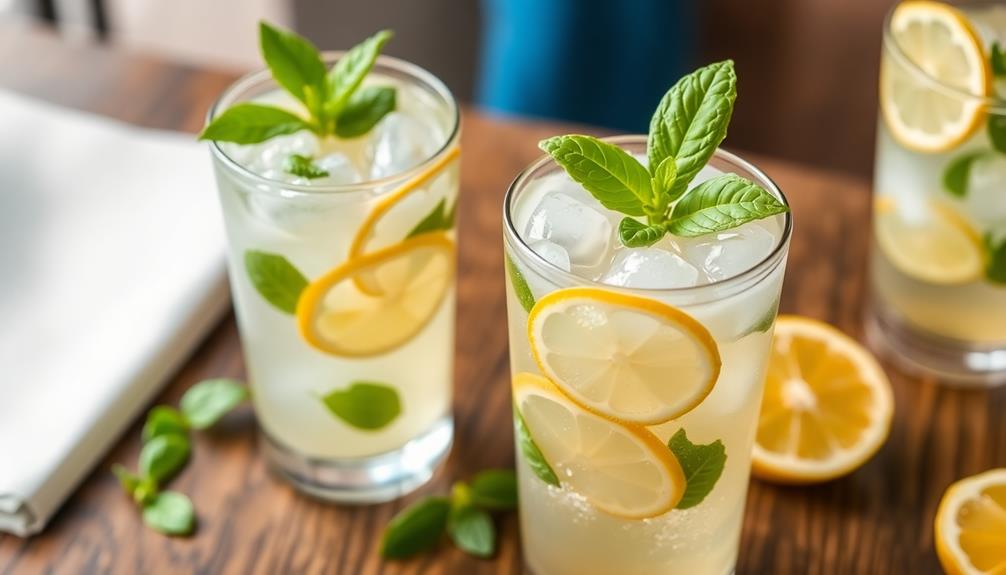
Serve the Lemon Basil Spritz immediately, chilled and refreshing. This cocktail is best enjoyed when it's ice-cold, as the crisp, zesty flavors truly shine through.
Pour the mixture over fresh ice in a highball glass to chill it quickly. The spritz should have a light, bubbly consistency, so be sure to top it off with the club soda at the last minute.
- For the perfect presentation, garnish the drink with a lemon slice and a sprig of fresh basil. The basil will release its aromatic oils as it sits in the drink, enhancing the herbal notes.
- Sip the Lemon Basil Spritz slowly and savor the balance of tart lemon, sweet basil, and effervescent club soda. It's a refreshing and sophisticated cocktail that's ideal for warm weather or as a palate cleanser between courses.
- Enjoy this spritz immediately for the best flavor and texture. The carbonation will start to dissipate over time, so it's best consumed right away while it's at its most crisp and refreshing.
Final Thoughts
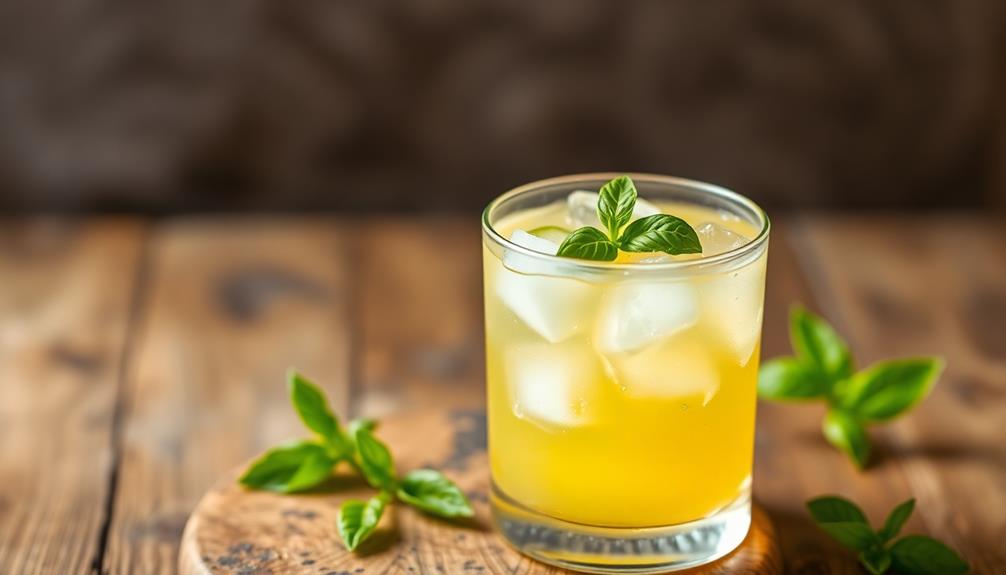
This lemon basil spritz is a refreshing and versatile cocktail that can be enjoyed year-round. The combination of bright lemon, fragrant basil, and effervescent soda water creates a delightful and well-balanced drink.
Whether you're hosting a summer gathering or looking for a light and refreshing option to wind down your day, this spritz is sure to please.
One of the best things about this cocktail is its adaptability. You can adjust the ratios of ingredients to suit your personal taste preferences, making it a perfect canvas for experimentation.
Additionally, the use of readily available ingredients means you can easily whip up a batch on a whim.
As you sip this lemon basil spritz, let the flavors transport you to a warm, sunny day. The bright citrus and herbaceous notes provide a refreshing contrast, making this cocktail a versatile choice for any occasion.
Cheers to enjoying this perfect balance of flavors!
Frequently Asked Questions
How Long Does the Lemon Basil Spritz Keep Fresh?
The freshness of your beverage depends on various factors, but you can generally expect it to remain fresh for 3-5 days when stored properly in the refrigerator. Pay attention to any signs of spoilage and consume it within that timeframe.
Can I Substitute Another Herb for the Basil?
You can absolutely substitute another herb for the basil in this recipe. Thyme, oregano, or even cilantro would work well, adding their own unique flavors to the lemon-based spritz.
Is the Lemon Basil Spritz Suitable for Vegans?
Absolutely! The lemon basil spritz is vegan-friendly as it doesn't contain any animal-derived ingredients. You can enjoy this refreshing beverage without compromising your dietary preferences. Just make sure to use plant-based sweeteners or omit them entirely if desired.
Can I Make the Lemon Basil Spritz in Advance?
Yes, you can make this drink in advance. Simply prepare the ingredients and refrigerate until ready to serve. When it's time, assemble the spritz and enjoy its fresh, vibrant flavors.
How Do I Adjust the Sweetness of the Lemon Basil Spritz?
To adjust the sweetness, start by reducing the amount of simple syrup. You can also experiment with adding more lemon juice or a splash of club soda to balance the flavors. Taste and adjust until it's just right.
Mario’s creativity shines through his ability to describe the sensory experience of enjoying ice cream. Whether he’s discussing the velvety texture, the explosion of flavors, or the delightful combinations of toppings and sauces, his words transport readers to a world of mouthwatering sensations. His descriptive language allows readers to imagine and savor the flavors even before taking the first bite.
Frozen Delights
Raspberry Spritz
Presenting the Raspberry Spritz, a delightful Italian cocktail with a vibrant appearance that will leave you craving more. Explore the tasty variations within.
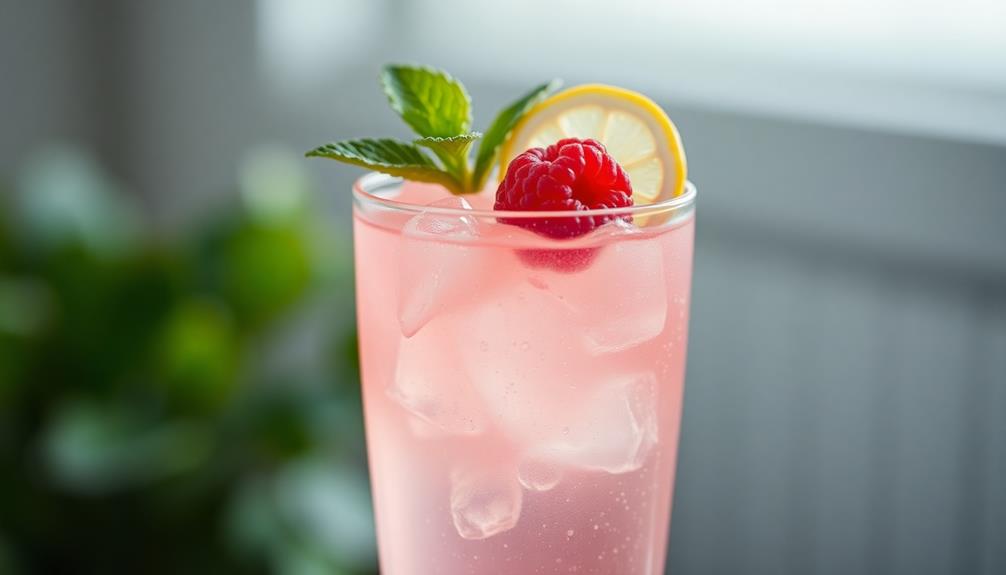
The Raspberry Spritz is a delightful Italian cocktail that's evolved from the classic Aperol Spritz. You'll get a balanced, refreshing flavor by muddling fresh raspberries, adding sparkling wine or Prosecco, club soda, and a touch of sweetness. Its vibrant appearance has made it popular among cocktail enthusiasts. To make it, simply muddle the raspberries, then top with the bubbly base, adjusting the sweetness to your taste. Serve over crushed ice and garnish with more raspberries and lemon for a visually stunning drink. Want to try some tasty variations? Keep reading to explore your options.
Key Takeaways
- The Raspberry Spritz is a modern classic cocktail that evolved from the traditional Aperol Spritz by using raspberry liqueur.
- The cocktail has a balanced and refreshing flavor profile, made with fresh raspberries, sparkling wine, and club soda.
- The vibrant appearance and versatility of the Raspberry Spritz make it a popular choice among cocktail enthusiasts.
- Preparation involves muddling fresh raspberries, adding simple syrup, and topping with sparkling wine and club soda.
- Variations can be created by substituting raspberries with other berries, using flavored sparkling water, or making a non-alcoholic version with sparkling juice.
History
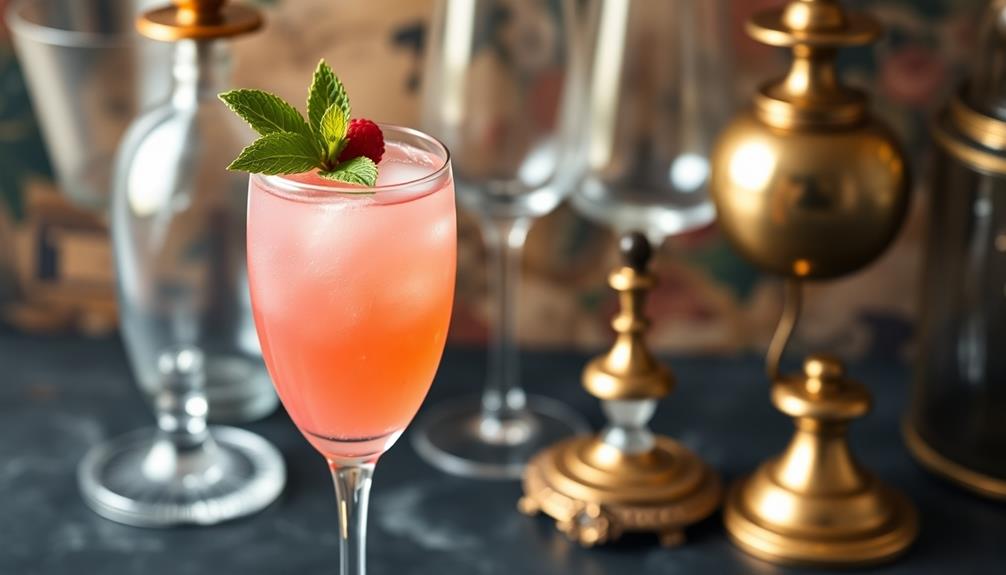
Originating in the early 20th century, the Raspberry Spritz has its roots firmly planted in the vibrant cocktail culture of Italy. This effervescent libation was born out of the Aperol Spritz, a beloved summertime staple, but with a unique twist. By swapping Aperol for a tart and tangy raspberry liqueur, the Raspberry Spritz breathes new life into the classic recipe, creating a balanced and refreshing drink that perfectly captures the essence of the Italian Riviera.
The Raspberry Spritz quickly gained popularity, becoming a favorite among discerning imbibers who appreciated its complex flavor profile and eye-catching appearance.
With its vibrant hue and delicate sparkling effervescence, the Raspberry Spritz has become a modern classic, effortlessly bridging the gap between tradition and innovation. As the cocktail scene continues to evolve, this versatile and crowd-pleasing libation remains a steadfast favorite, capturing the hearts and palates of both seasoned and novice drinkers alike.
Recipe
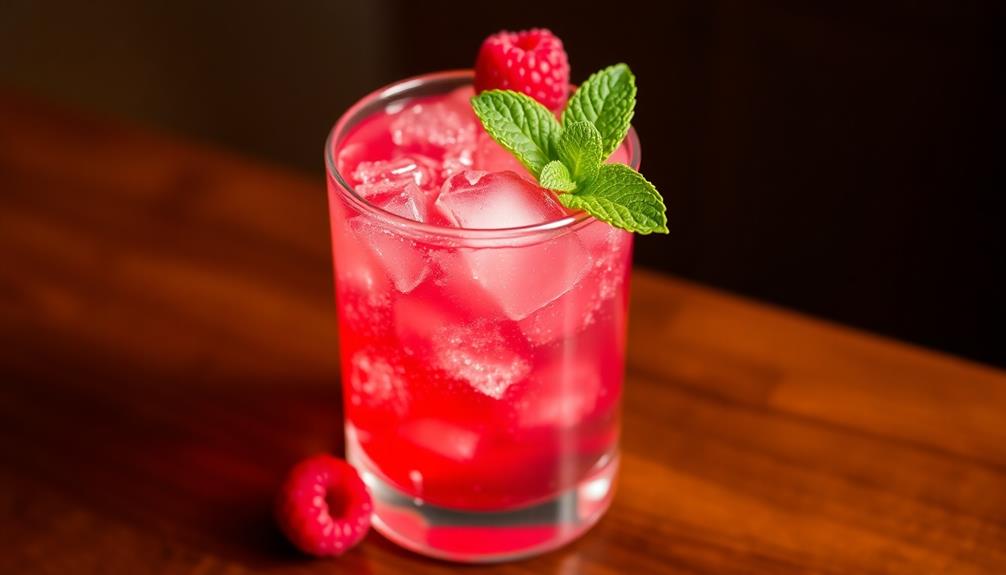
The Raspberry Spritz is a refreshing and delightful cocktail that combines the tartness of raspberries with the effervescence of sparkling wine. This easy-to-make drink is perfect for summer gatherings or as a festive aperitif.
To create the perfect Raspberry Spritz, you'll need a few simple ingredients and a bit of time to let the flavors infuse. The result is a beautifully colored and subtly sweet cocktail that will impress your guests and tantalize your taste buds.
Ingredients:
- 1 cup fresh raspberries
- 1/4 cup granulated sugar
- 1/4 cup water
- 1 bottle chilled sparkling wine or Prosecco
- Fresh raspberries and lemon slices for garnish
Instructions:
In a small saucepan, combine the raspberries, sugar, and water. Bring the mixture to a simmer over medium heat, stirring occasionally, until the sugar has dissolved and the raspberries have released their juices, about 5-7 minutes.
Remove from heat and let cool completely.
Strain the raspberry syrup through a fine-mesh sieve, pressing on the solids to extract as much liquid as possible. Discard the solids.
In a pitcher or large measuring cup, combine the raspberry syrup and chilled sparkling wine. Stir gently to combine.
Serve the Raspberry Spritz over ice in glasses, garnished with fresh raspberries and lemon slices.
Tips:
For a sweeter cocktail, adjust the amount of sugar to your taste.
You can also experiment with different types of sparkling wine or Prosecco to find your preferred flavor profile.
Additionally, you can make the raspberry syrup in advance and store it in the refrigerator for up to one week, allowing for quick and easy cocktail assembly when ready to serve.
Cooking Steps

First, grab a glass and start muddling some fresh raspberries to release their juices.
Next, top it off with some refreshing soda water and your choice of vodka or gin.
Step 1. Muddle Fresh Raspberries in Glass
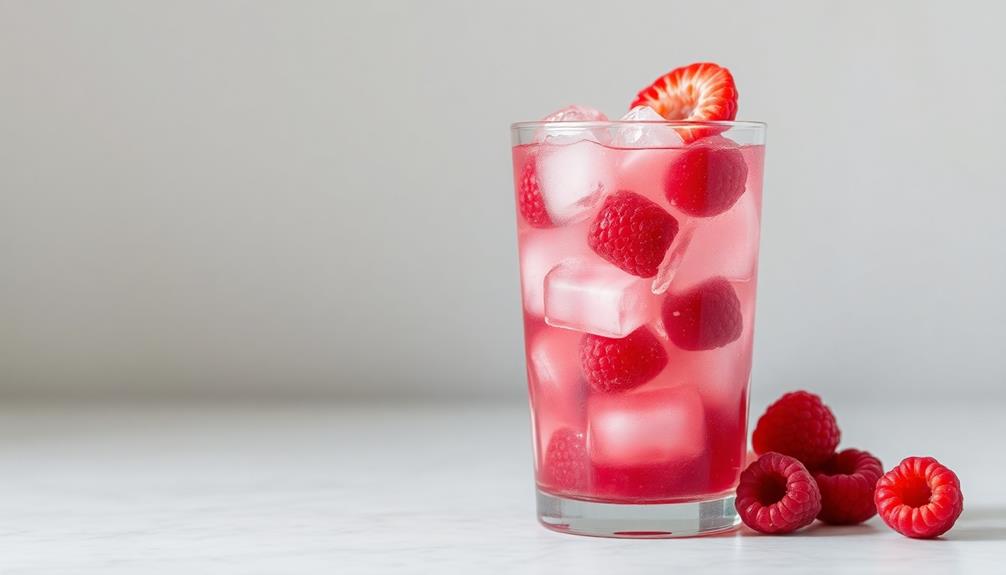
Juicy raspberries take center stage in this refreshing spritz. Start by grabbing a glass and adding a few handfuls of fresh raspberries.
Using a muddler or the back of a spoon, gently crush the berries to release their vibrant juices and aromas. Be careful not to over-muddle, as you want to maintain some texture and shape to the raspberries.
Once the raspberries are nicely muddled, add a splash of simple syrup or honey to sweeten the drink to your taste. Stir the mixture gently to combine.
Next, pour in a shot of chilled vodka or gin, followed by a squeeze of fresh lemon juice for a tart and refreshing balance.
Step 2. Add Soda Water
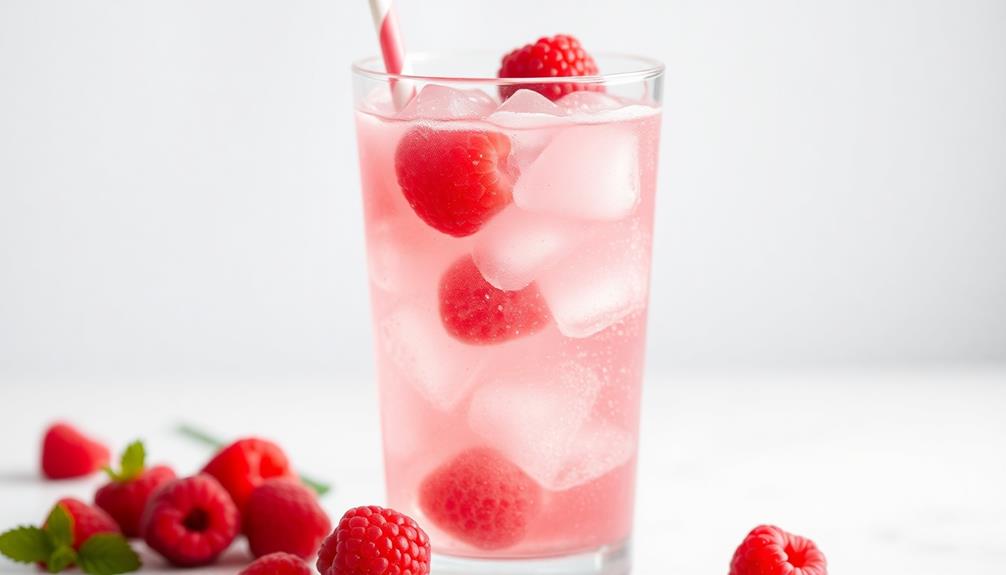
Add a generous splash of chilled soda water to the muddled raspberry mixture, giving the drink its signature spritz. The carbonation from the soda water will bring a lively, effervescent quality to the Raspberry Spritz, complementing the sweet-tart flavor of the raspberries.
For the best results, use a high-quality soda water or club soda. Avoid tonic water, as its quinine flavor can overpower the delicate raspberry notes. Aim for about a 1:1 ratio of soda water to the muddled raspberry mixture, adjusting to personal preference.
Gently stir the ingredients together, being careful not to over-dilute the drink. The soda water not only provides fizz but also helps to chill and dilute the drink to the perfect consistency.
This creates a refreshing, easy-to-sip cocktail that's perfect for warm weather or as a festive aperitif. Enjoy your Raspberry Spritz over ice for maximum enjoyment.
Step 3. Add Vodka or Gin
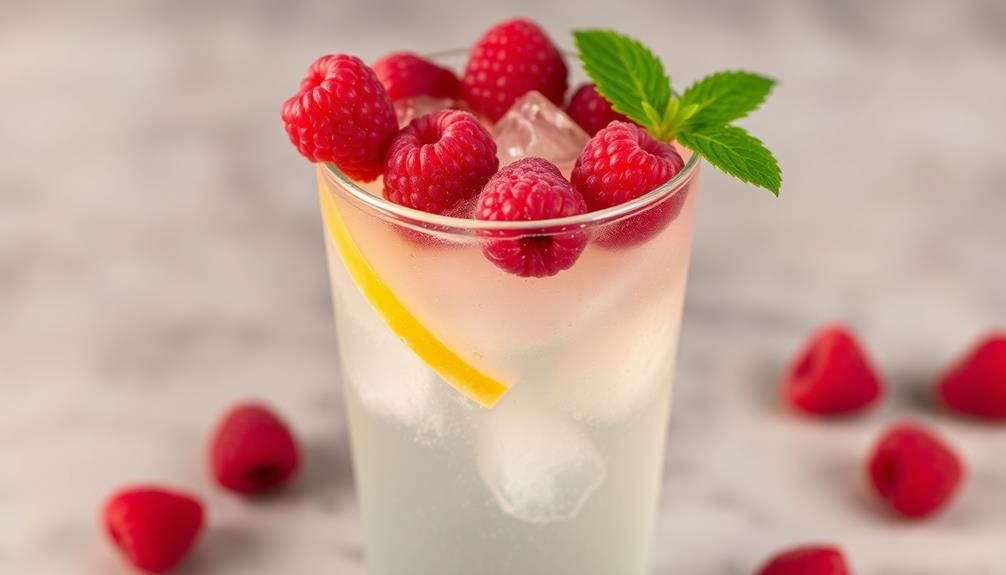
With the soda water adding effervescence, the Raspberry Spritz is now ready for a spirit boost. You can choose between vodka or gin to complement the sweet-tart raspberry flavor.
Vodka provides a neutral base, allowing the raspberry to shine, while gin lends a subtle botanical note that can enhance the drink's complexity.
When adding the spirit, start with 1-1.5 ounces per serving, depending on your personal preference. Gently stir to incorporate the vodka or gin into the raspberry-soda mixture.
Taste and adjust the amount as desired, keeping in mind that the alcohol content will affect the overall balance of the cocktail.
For a festive presentation, garnish the Raspberry Spritz with a lemon twist or fresh raspberries. The vibrant color and fizzy texture make this cocktail a refreshing and visually appealing choice, perfect for warm-weather sipping or as a celebratory sipper.
Step 4. Garnish With Lemon Twist
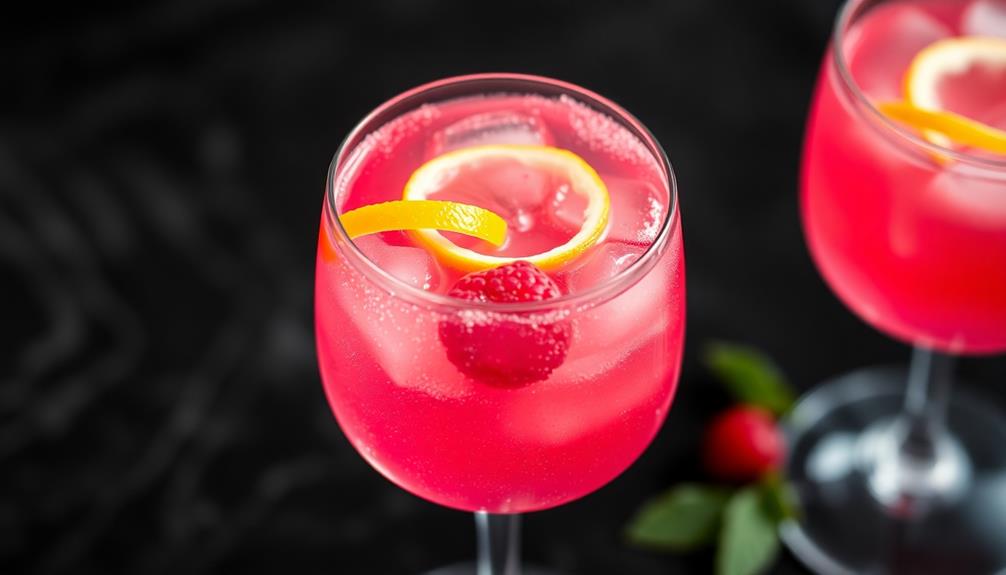
Grab a lemon and take a sharp paring knife to peel off a twist, making sure to avoid the bitter white pith. Carefully twist and peel the zest in one continuous strip, revealing the bright, fragrant yellow oils.
This lemon twist will serve as the perfect garnish for your Raspberry Spritz, adding a refreshing citrus aroma and a vibrant pop of color to the drink.
Once you've secured your lemon twist, gently express the oils over the surface of the drink by twisting and squeezing the peel above the glass. This will release the essential oils, infusing the Spritz with an irresistible lemon scent.
Step 5. Serve Over Crushed Ice
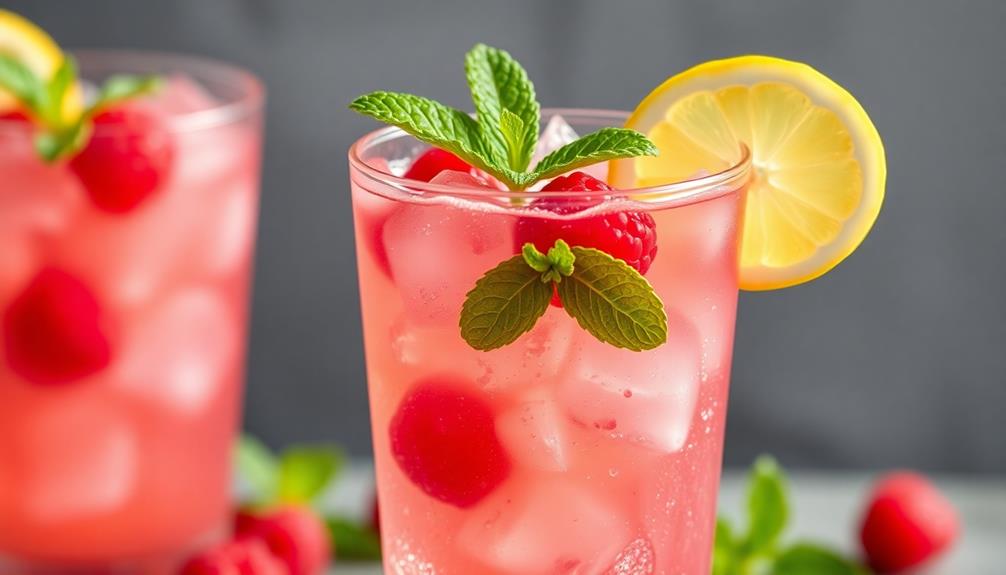
Fill a highball or Collins glass with crushed ice, ensuring it's packed in tightly. This provides a chilled, textured base for the Raspberry Spritz, allowing the flavors to shine.
The crushed ice also creates a visually appealing presentation, with the fizzing and swirling of the drink over the ice.
Next, carefully pour the raspberry-infused prosecco or sparkling wine into the glass, allowing it to cascade over the crushed ice. The bubbles will create a lively, refreshing effect.
Slowly add the raspberry liqueur, letting it gently mix with the sparkling wine.
Final Thoughts
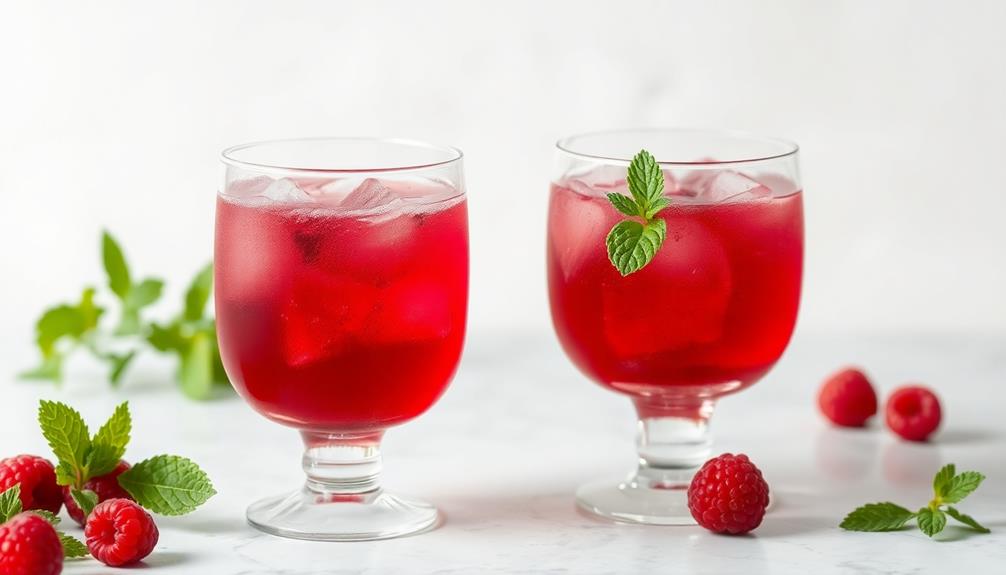
A delightful Raspberry Spritz is a refreshing way to cap off any gathering. This vibrant cocktail combines the tartness of raspberries with the effervescence of sparkling wine, creating a truly memorable experience.
The crushed ice adds a delightful chill, while the garnishes elevate the visual appeal. Pairing this drink with savory appetizers like crab cakes can enhance the overall enjoyment of your gathering.
When crafting this spritz, be mindful of the balance between the sweet and tart flavors. Adjust the raspberry purée to suit your taste preferences, ensuring the drink is neither too sweet nor too sour. The addition of a lemon twist or mint sprig can provide a lovely aromatic touch, complementing the overall flavor profile.
As you savor your Raspberry Spritz, take a moment to appreciate the vibrant hues and the satisfying fizz. This cocktail is a perfect way to end the evening, leaving your guests with a refreshing and delightful impression.
Cheers to the Raspberry Spritz!
Frequently Asked Questions
How Long Does the Raspberry Spritz Cocktail Keep?
The raspberry spritz cocktail keeps for about 2-3 days when stored properly in the refrigerator. It's best to consume it within this timeframe to enjoy its fresh and fizzy flavor.
Can I Use Frozen Raspberries Instead of Fresh?
You can absolutely use frozen raspberries instead of fresh. The texture and flavor will be slightly different, but it'll work just fine. Just be sure to let the frozen berries thaw before using them in your cocktail.
What Is the Best Type of Gin to Use?
When choosing gin for your cocktail, you'll want to pick a high-quality, flavorful gin that can hold its own against the tartness of the raspberries. Look for a London Dry or barrel-aged gin to complement the spritz.
Is the Raspberry Spritz Suitable for Non-Alcoholic Versions?
Yes, the raspberry spritz can be made into a non-alcoholic version. You can use a raspberry syrup or concentrate and sparkling water to create a refreshing, berry-infused mocktail that everyone can enjoy.
Can I Substitute the Lemon Twist for Another Garnish?
Absolutely, you can substitute the lemon twist for another garnish. The beauty of cocktails is their customizability. Feel free to experiment with different fruits, herbs, or even edible flowers to find the perfect garnish that suits your taste.
Mario’s creativity shines through his ability to describe the sensory experience of enjoying ice cream. Whether he’s discussing the velvety texture, the explosion of flavors, or the delightful combinations of toppings and sauces, his words transport readers to a world of mouthwatering sensations. His descriptive language allows readers to imagine and savor the flavors even before taking the first bite.
-

 Frozen Delights3 months ago
Frozen Delights3 months agoBest Gelato in Napoli – Neapolitan Delights
-

 Frozen Delights3 months ago
Frozen Delights3 months agoBest Gelato in Firenze – Florence's Sweet Spots
-

 Frozen Delights3 months ago
Frozen Delights3 months agoBest Gelato in Philly – Philadelphia's Finest
-

 Frozen Delights3 months ago
Frozen Delights3 months agoBest Gelato in Pisa – Sweet Treats in the City of the Leaning Tower
-

 Frozen Delights3 months ago
Frozen Delights3 months agoBest Gelato in Orlando – Cool off With the Best
-

 Ice Cream Recipes3 months ago
Ice Cream Recipes3 months agoExotic Treat: Best Ube Ice Cream Recipe!
-

 Ice Cream Recipes3 months ago
Ice Cream Recipes3 months agoVanilla Perfection: Best Vanilla Ice Cream Recipe!
-

 Ice Cream Recipes3 months ago
Ice Cream Recipes3 months agoMaker Magic: Best Vanilla Ice Cream Recipe for Ice Cream Maker!



































